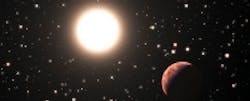Spectrograph finds three new planets in Messier 67 star cluster
For the past six years-plus, the European Southern Observatory’s (ESO) high accuracy radial velocity planet searcher (HARPS) spectrograph has been monitoring 88 selected stars in the Messier 67 star cluster to look for signs of movement of the stars toward and away from Earth, which may reveal the presence of orbiting planets. At long last, HARPS has found something, as three new planets were discovered.
HARPS, which is on the ESO’s 3.6-meter telescope at the La Silla Observatory in Chile, is built to obtain a long term radial velocity on the order of 1 m/s, according to ESO. The echelle spectrograph features an image detector that consists of a mosaic of two CCD sensors, which are nicknamed "Jasmin" and "Linda." Both CCDs feature a 4,096 x 4,096 pixel (4k) format with a 15 µm x 15 µm pixel size, of which a field of 62.7 x 61.4 mm is actually used, at a sampling of 4 pixels per spectral element. The detectors are cooled by a continuous flow of cryostat, and the detector head window serves as the field lens of the camera optics. The upper CCD, Jasmin, features a spectral range of 533-691nm, while the lower CCD, Linda, features a spectral range of 378-530nm.
HARPS monitored the Messier 67 area, which is about 2,500 light years away in the constellation of Cancer and contains about 500 stars. Two of the planets that were discovered have about one third the mass of Jupiter and orbit their host stars in seven and five days, respectively. The third planet takes 122 days to orbit its host and is larger than Jupiter.
The first planet discovered, however, was orbiting a star that is one of the most similar solar twins identified thus far, being almost identical to the sun. Its discovery marks the first solar twin in a cluster that has been found to have a planet. The other two planets are “hot Jupiters”, which are planets close in size to Jupiter, but much closer to their parent star. All three planets, however, are closer to their host starts than the habitable zone where liquid water could exist.
View the ESO press release.
Also check out:
Gemini Planet Imager captures photo of planet 63 light years from Earth
Telescope discovers asteroid, asteroid still hits Earth
2013 highlights in vision: Aerospace imaging
Share your vision-related news by contacting James Carroll, Senior Web Editor, Vision Systems Design
To receive news like this in your inbox, click here.
Join our LinkedIn group | Like us on Facebook | Follow us on Twitter | Check us out on Google +
